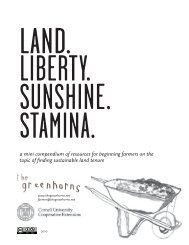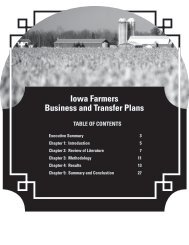I Believe in the Future of Farming[1] John Ikerd[2] I ... - Greenhorns
I Believe in the Future of Farming[1] John Ikerd[2] I ... - Greenhorns
I Believe in the Future of Farming[1] John Ikerd[2] I ... - Greenhorns
You also want an ePaper? Increase the reach of your titles
YUMPU automatically turns print PDFs into web optimized ePapers that Google loves.
make knowledge more easily acquired and creativity and entrepreneurship more<br />
effectively used. Susta<strong>in</strong>able farm<strong>in</strong>g does not mean go<strong>in</strong>g back to “40 acres and a<br />
mule;” it means go<strong>in</strong>g forward to farm<strong>in</strong>g that relies more uniquely human productive<br />
capacities.<br />
Communities <strong>of</strong> <strong>the</strong> future will be those that have preserved and restored <strong>the</strong> fertile<br />
farmlands that rema<strong>in</strong>ed <strong>in</strong> <strong>the</strong> areas where most <strong>of</strong> <strong>the</strong> cities and towns <strong>in</strong> America were<br />
<strong>in</strong>itially settled. They will be communities that understand today’s local food movement<br />
is not just about restor<strong>in</strong>g healthy diets and healthy bodies, although health is obviously<br />
essential to physical well-be<strong>in</strong>g. Local foods will provide both <strong>the</strong> motivation and means<br />
<strong>of</strong> reconnect<strong>in</strong>g people <strong>in</strong> mean<strong>in</strong>gful personal and social relationships. Local food<br />
systems also will allow people to support <strong>the</strong>ir local farmers economically and thus<br />
support <strong>the</strong>ir local economies. Through local farmers, people will reconnect spiritually<br />
with <strong>the</strong> land and rega<strong>in</strong> a sense <strong>of</strong> purpose and mean<strong>in</strong>g <strong>in</strong> life through a commitment to<br />
<strong>the</strong> stewardship <strong>of</strong> nature. Farmers will aga<strong>in</strong> be held <strong>in</strong> high esteem as <strong>the</strong> icons <strong>of</strong><br />
democracy and <strong>the</strong> caretakers <strong>of</strong> <strong>the</strong> future <strong>of</strong> humanity.<br />
The hope for a brighter future <strong>in</strong> farm<strong>in</strong>g is seen most clearly <strong>in</strong> susta<strong>in</strong>able<br />
agriculture. The movement <strong>in</strong>cludes farmers who call <strong>the</strong>mselves organic, ecological,<br />
biodynamic, holistic, practical, <strong>in</strong>novative, or just pla<strong>in</strong> family farmers. What <strong>the</strong>y have<br />
<strong>in</strong> common is <strong>the</strong>ir commitment to creat<strong>in</strong>g a permanent agriculture that can meet <strong>the</strong><br />
needs <strong>of</strong> <strong>the</strong> present without dim<strong>in</strong>ish<strong>in</strong>g opportunities for <strong>the</strong> future. They know <strong>the</strong>y<br />
must balance <strong>the</strong> need for economic viability with ecological and social <strong>in</strong>tegrity to<br />
achieve susta<strong>in</strong>ability. The numbers <strong>of</strong> such farmers is grow<strong>in</strong>g each year, as is evident at<br />
<strong>the</strong> dozens <strong>of</strong> susta<strong>in</strong>able agriculture conferences held annually all across <strong>the</strong> cont<strong>in</strong>ent.<br />
At least eight “susta<strong>in</strong>able agriculture” conferences <strong>in</strong> <strong>the</strong> U.S. and Canada each draw<br />
more than 1,200 participants each year, with a couple reach<strong>in</strong>g 2,500 to 3,000. The larger<br />
conferences typically are organized by grass-roots organizations and <strong>the</strong> vast majority <strong>of</strong><br />
those attend<strong>in</strong>g are farmers and <strong>the</strong>ir customers. Susta<strong>in</strong>able agriculture conferences<br />
draw<strong>in</strong>g 500-700 per year are common and conferences draw<strong>in</strong>g 100-250 are too<br />
numerous to attempt to count, <strong>in</strong>clud<strong>in</strong>g conferences <strong>in</strong> virtually every state <strong>in</strong> <strong>the</strong> U.S.<br />
The size and numbers <strong>of</strong> such conferences is grow<strong>in</strong>g each year as is <strong>the</strong> number <strong>of</strong><br />
young people attend<strong>in</strong>g.<br />
Perhaps even more important, <strong>the</strong>se new farmers are be<strong>in</strong>g supported by grow<strong>in</strong>g<br />
numbers <strong>of</strong> allies among o<strong>the</strong>r like-m<strong>in</strong>ded farm and non-farm groups. The Slow Food<br />
movement, for example, is a worldwide organization with about 100,000 members <strong>in</strong><br />
over 150 countries. Slow Food's approach to agriculture, food production and gastronomy<br />
is… def<strong>in</strong>ed by three <strong>in</strong>terconnected pr<strong>in</strong>ciples:, “Good: a fresh and flavorsome seasonal<br />
diet that satisfies <strong>the</strong> senses and is part <strong>of</strong> our local culture; Clean: food production and<br />
consumption that does not harm <strong>the</strong> environment, animal welfare or our health; Fair:<br />
accessible prices for consumers and fair conditions and pay for small-scale<br />
producers. [xi] Good, clean, and fair are becom<strong>in</strong>g <strong>the</strong> watchwords <strong>of</strong> <strong>the</strong> susta<strong>in</strong>able foods<br />
movement.


![I Believe in the Future of Farming[1] John Ikerd[2] I ... - Greenhorns](https://img.yumpu.com/38821670/7/500x640/i-believe-in-the-future-of-farming1-john-ikerd2-i-greenhorns.jpg)



